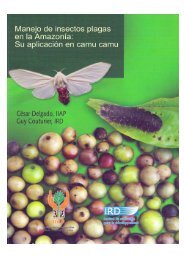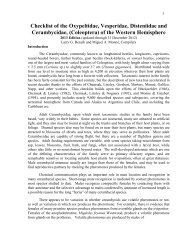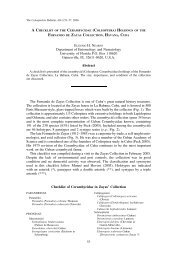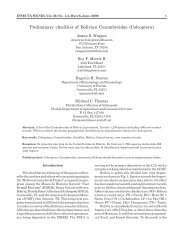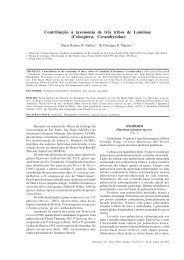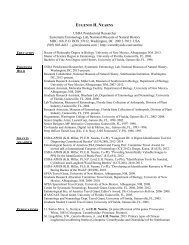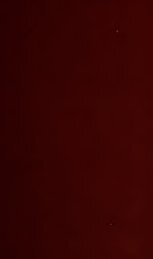You also want an ePaper? Increase the reach of your titles
YUMPU automatically turns print PDFs into web optimized ePapers that Google loves.
LAWRENCE S. DILLON <strong>AND</strong> ELIZABETH S. DILLON 69<br />
punctate across base, median line distinctly elevated, each side strongly tumid,<br />
tumescences traversed by a more or less distinct oblique line, which somewhat<br />
divides each into two tubercles, the inner ones being more strongly elevated.<br />
Seutellum transverse; sides nearly straight, oblique ; apex retuse, lateral angles<br />
produced and elevated. Elytra robust, sides gradually attenuate to apices, which<br />
are separately rounded; basal gibbosity broad, not prominent, entire base coarsely,<br />
irregularly, and densely punctate, punctures becoming finer behind middle but<br />
attaining apex; humeri slightly projecting, anterior margin straight, slightly or<br />
strongly oblique, the angle with a large, rounded tubercle, from which runs a feebly<br />
elevated and short carina; sides punctate as disk. Prosternum with a distinct trans<br />
verse process between coxae. Procoxae tumid posteriorly, anteriorly with a broad,<br />
feeble tubercle; femora clavate, mther slender, profernora finely rugose beneath;<br />
met.'l.tibiae greatly enlarged on apical half and densely setose there. Fifth ster<br />
nite one-fourth longer than fourth ; apex subtruneate. Antennae nearly as long<br />
as body, fimbriate beneath on four proximal segments; scape slender, somewhat<br />
capitate on apical two-fifths; third segment a little longer than first, distinctly bi<br />
f1exose; rest gradually shorter, the eleventh with only a minute process at apex.<br />
FEMALE . Antennal tubercles even less distinctly armed at apex ; profemora<br />
no' rugoe beneath; metatibiae unmodified; fifth sternite nearly t,wice length of<br />
fourth, apex retuse, feebly impressed medially; antennae distinctly shorter than<br />
body; scape more slender.<br />
LENGTH 16.5-20 mm., width 7-8.9 mm.<br />
Holotype.-Male; San Rafael, Ecuador ; (F. Campos R.) ;<br />
[U.S.N.M. number 57215] .<br />
Allotype.-Female; Costa Rica ; [U.S.N.M.].<br />
Pamtype.-Malc; Vol. de Chiriqui, 4000-6000 ft. ; (Champion) ;<br />
[U.S.N.M.].<br />
Charoides pallida Dillon and Dillon, spec. nov.<br />
PLATE IV, FLGlJlIE 9.<br />
Distinct from C. antennata sodalis in the elytra having tbe me<br />
dian fascia distinct, the broad basal gibbosities more promincnt ;<br />
front morc strongly widened below eye j and fifth sternite largely<br />
pale pubescent.<br />
MALE. Elongate-ovate, robust, convex; fuscous, covered with pale gray and<br />
light fulvous pubescence, mottled or variegated with brown and light brown pub<br />
escence. Head with front brown pubescent, laterally and below hoary variegated, at<br />
middle on each side of median line a short streak of hOilry. Pronotum each side with<br />
a fine vitta of pale fulvous and hoary pubescence runnillg from above basal angle to<br />
front one, somewhat interrupted at middle. Scutellum pale brown medially, each<br />
side margined with hoary pubescence, margin broader toward base. Elytra at



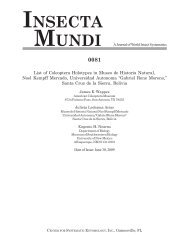
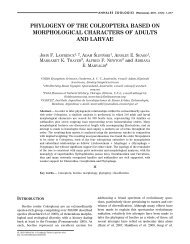


![Coleoptera. Vol. I. [Longicornia. Part I.]](https://img.yumpu.com/41202793/1/180x260/coleoptera-vol-i-longicornia-part-i.jpg?quality=85)
